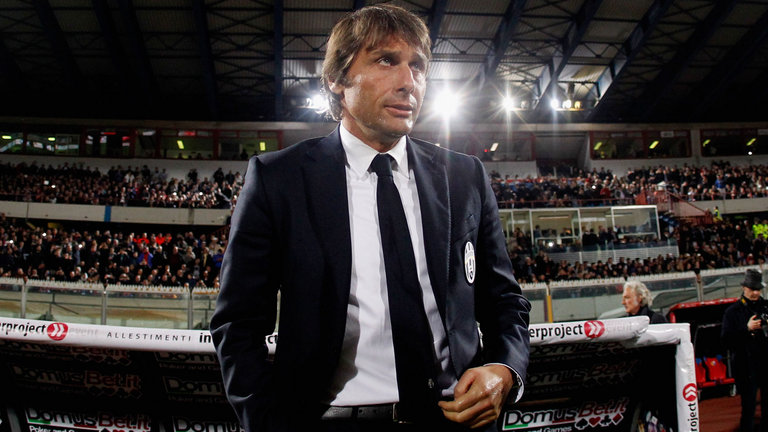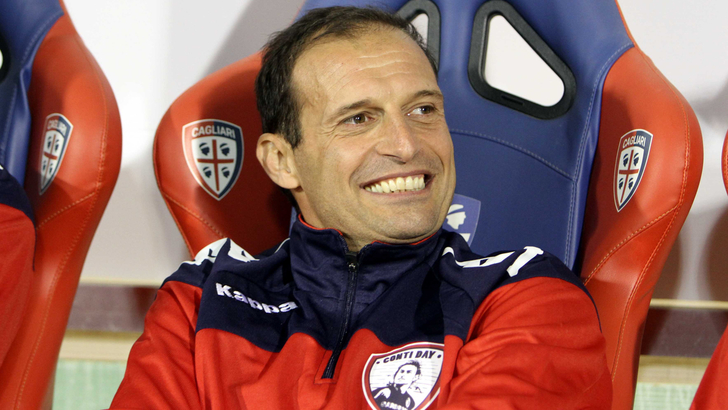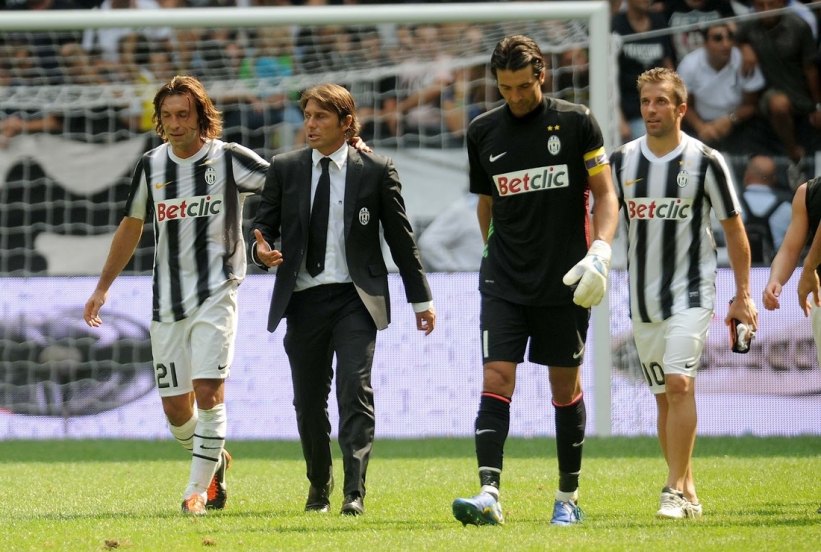Juventus are a strange anomaly among the traditional footballing giants of Europe. This is a club whose fans were surprised by a new badge mid-season, and yet there was no significant uproar. They have had multiple permanent stadiums over the years, including three in this millennium alone. Meanwhile, fans at the Emirates and Allianz Arena are still grumbling about their new surroundings.
Considering their incredibly diverse fan base – Juventus draw followers from across Italy, often outstripping support for local teams – it is not surprising that these conventional ideas of traditions do not hold sway. In their place stands a single, outstanding custom; their incredible and sustained domestic dominance.
In 2011, this underlying thread of success was in danger. Following the Calciopoli scandal in the middle of the previous decade, Juventus had been stripped of their titles in 2005 and 2006 and relegated to Serie B. Despite returning to the top flight at the first time of asking, the Old Lady of Turin had not officially won the championship since 2003.
The last time Juventus had gone that long without a title was in the late 1980s and early 1990s. Twenty years ago, they were up against the formidable might of Maradona’s Napoli and Arrigo Sacchi’s AC Milan. In 2011, Serie A teams were the laughing stock of European football. Juventus were on the verge of becoming a forgotten giant. They needed a revival of fortunes – a return to past glories.
22 May 2011, Udinese 0-0 AC Milan: The Spark
In May 2011, as Massimiliano Allegri’s AC Milan were celebrating a surprise Scudetto, Juventus were stumbling to their second consecutive seventh place finish. Luigi Del Neri, the Turin-based club’s fourth manager in three years, saw the end coming. In his final press conference he said, “I hope it [my sacking] is the right choice. Good luck to whoever replaces me.” Clearly not the words of someone who believes he failed, but rather those of a man who thought the club had failed him.
The next day, Juventus announced Del Neri’s successor – ex-club captain and terrace hero Antonio Conte. The Puglian midfielder had made over 400 appearances for the Bianconeri, retiring in 2004 with 15 major honours to his name. However, despite his obvious talent, there had always been a whiff of what can be called the Gary Neville Syndrome. While many others have sustained their standing through talent, Conte’s greatest gift was his sheer determination and willingness to work hard.
One can only assume that it was this ruthless mentality and obvious love for the badge that attracted the Juventus board to Antonio Conte, because his managerial achievements were decidedly underwhelming. Although he had achieved promotions from Serie B with both Bari and Siena, his only stint in Serie A, with Atalanta, had led to the sack after just 14 matches.
That is not to say there were no glimpses of his managerial potential. At both Bari and Siena, his teams had received high praise for their high pressing, all action 4-2-4 systems. At a time when Pep Guardiola was receiving continental praise for a fluid, aggressive passing game, Conte was implementing those tactics on a smaller scale. The bigger doubt was his ability to effect these changes in the unrealistic pressure-cooker that surrounds traditional giants like Juventus.
In addition to the external media spotlight, Conte also had to deal with problems within the club. The summer saw incoming transfers for Andrea Pirlo, Arturo Vidal, Stephan Lichsteiner and Mirko Vucinic. Despite the impact that we know those players have eventually had, they were seen as risky investments at the time. Even Pirlo, who was to have one of his best ever seasons, was regarded a liability that would struggle to perform in Conte’s preferred 4-2-4 formation, including by the coach himself.
Furthermore, there was also the issue of growing fan discontent. The years of underachievement had led to rapidly dropping attendances – Juventus’ highest attendance in the 2010-11 season was under 25,000 people. In response, the Bianconeri had finally opened their new stadium in the summer of 2011, unimaginatively named the Juventus Stadium. Despite Pirlo’s statement that the new stadium had more potential to intimidate opposition than the San Siro, the team still had to make sure they weren’t to be the victims of that atmosphere.
Thus, on the eve of the new season, expectations were low for Conte’s side. Instead, the media was looking forward to whether Inter could regain the title from their cross-town rivals. No one was predicting the revolution that was about to unfold in Turin.
11 September 2011, Juventus 4-1 Parma: The Realisation
The first match of the season saw Juventus line up in the expected 4-2-4 formation, and easily dispatch Parma in a confident display of attacking football. On the face of it, the victory was an early vindication of Conte’s tactics and his ability to transplant them to the biggest club in Italy. However, the new coach realised something important in the last 22 minutes of that match – the implications of Vidal’s performance after coming on as substitute.
Due to that summer’s Copa America, the Chilean midfielder had made his way to Juventus’ pre-season training late. Combined with his limited Italian, relative tactical naivety and his need to adjust to new surroundings, Conte was not too impressed by his new recruit’s ability. In fact, there are even stories that the new coach had to quite literally drag Vidal around by the arm during training sessions to indicate what he wanted the midfielder to do.
However, Vidal’s performance against Parma transformed Conte’s ideas. The manager had already expressed misgivings about his side’s ability to adapt to the 4-2-4, as well Pirlo’s physical decline as a result of the ravages of time. Suddenly, he noticed that he had an all-action midfielder that could solve those problems.
The Chilean’s magical ability to seemingly do the work of two men – he finished the season with 5.6 tackles per match, the highest in Serie A – could gift Pirlo the time and space to pull the strings from midfield. In combination with the galvanising forward play of Claudio Marchisio, Juventus now potentially owned the most potent midfield in the league. To get the best out these players, Conte willingly switched to a 4-3-3 system.
While the new formation seemed to work in the first few weeks, the real test came against defending champions AC Milan on matchday five. Although Allegri’s side had started the season in dismal form, picking up just 5 points in the first 4 games, they were still favourites to reassert their claim to the title. In the end, Juventus claimed a 2-0 victory courtesy of two extremely late Marchisio finishes. More importantly, they had deserved that margin of victory by showing an ability to press effectively, and a knack of knowing when to burst forward. Conte’s tactical switch had been vindicated.
Success in Sardinia: Allegri and the Cagliari years
29 November 2011, Napoli 3-3 Juventus: The Improvisation
Following that victory, Juventus did not look back. They continued picking up points at a surprising rate, making them favourites to pick up the symbolic title of Winter Champions. However, before they could claim that reward, they had to face Napoli at the intimidating cauldron of seething hatred known as the Stadio San Paolo.
While Conte’s revolution was in full swing by this point, the Puglian knew that he was coming up against a team further along in the process. Walter Mazzarri’s appointment in 2009 had made the city of Naples believe in their team again, as his radical 3-4-3 formation had made the Partenopei a significant force once again. Not only did the formation encourage wide men Christian Maggio and Juan Camilo Zuniga to get forward, but also allowed Mazzarri to play his three most creative players at the same time – Marek Hamsik, Goran Pandev and Ezequiel Lavezzi.
Conte realised that his favoured 4-3-3 would not be able to withstand the onslaught of Napoli’s attack, and pulled a last-minute surprise on the hosts. While everyone expected Juventus to line up as such, they ran out in a 3-5-2 formation. The tactical change worked a treat, as the two Italian giants played out a titanic 3-3 draw. Despite this success, Conte did not recognise the potential of what he had just witnessed.
The experiment was forgotten until Juventus travelled to Roma in the Coppa Italia in January, where it provided the foundation for yet another impressive away performance. This did convince Conte to use the three-man backline on occasion, although the 4-3-3 remained the Bianconeri’s staple diet.
1 April 2012, Juventus 3-0 Napoli: The Reality
Juventus’ biggest problem since their return to the top flight had been an inability to successfully see out a season. An inability to complete title challenges in 2008 and 2009, under former perennial bridesmaid Claudio Ranieri, were obvious examples, but Del Neri’s sole season in charge had also fallen to this new tradition. At the turn of the year in the 2010-11 season, Juventus had been on a decent run of form and were expected to finish in the top four. However, a calamitous 1-4 home loss to Parma on the first matchday of the new year preceded a collapse that eventually led to the aforementioned seventh placed finish.
Thus, when Juventus eked out an undeserved away victory against Lecce on the first matchday of 2012, Conte’s side were lauded for their mental fortitude. Yet, this was to precede an unexpected sequence of draws in February and March that left them in second behind a resurgent AC Milan. Going into April, Juventus had managed just three wins in their previous nine league games. With Allegri’s team promising a strong finish to the season, Conte needed to spark a revival of fortunes starting with a victory against Napoli on matchday thirty.
Upon meeting Mazzarri’s men once again, Conte decided to revert to the trusted 3-5-2 to counter Napoli’s threat. To everyone’s surprise, it not just nullified the Neapolitans but unleashed the full prowess of Juventus’ considerable attacking talent. The performance finally convinced Conte of the formation’s potential, which he proceeded to use for the last eight matches of the season.
In addition to a demonstration of Conte’s tactical maturity, the first week of April also portrayed another of his managerial traits – the raw ability to motivate his players. In a now famous 12-minute speech, Conte railed at his players, who he feared were starting to get complacent. Rather than trying to explain the power of his words, it is worth just reproducing a section:
People are flooding us with praise right now, but that sends shivers through me. Why? Because I have fear, I have fear that someone here will start to relax. There is applause and a consensus, but what is the reality? The reality is the pitch, the reality is sweat, the reality is sacrifice…We are mature enough to fight until the very end. As I said before, they [Milan] will have to spit blood until the last game.
Inspired by both Conte’s sheer will to win and the attacking freedom created by the switch to the 3-5-2, Juventus went on to win seven of their last eight matches. They secured their first official Scudetto in nine years with a game to spare. Impressively, they also became the first Italian team to go unbeaten through a 38-game season. All the pre-season doubts about Conte’s suitability for the job had disappeared – the returning captain had dragged Juventus back from the brink.
Pirlo, Conte, Buffon and Del Piero during Juve’s 2011-12 unbeaten season
The numbers behind Juventus’ 2011-12 title are a sight to behold. Despite being the second highest scorers in the league with 68 goals, their highest scorer was Alessandro Matri with 10 goals. Instead, the strikes were spread out among an unbelievable 21 different scorers, out of a league-high total of 25 players that made an appearance. Claudio Marchisio deserves a special mention for his nine goals, an incredible achievement for a midfielder. Juventus only failed to score in five matches all season.
Moving further back the pitch, the numbers continue to impress. 21 clean sheets and only 20 goals conceded, both league records (in Serie A’s 38-team format), paved the foundation for a 27-point improvement over 2010-11. However, nothing emphasises Juventus’ transformation like Pirlo’s development.
Regarded to be near the end of his career in the summer of 2011, he was ruthlessly released at the end of his AC Milan contract. The midfielder would go on to register a league-high 13 assists for Juventus, and inspire Italy to the final of the European Championship in the summer of 2012. He eventually placed fourth in the Best Player in Europe award, behind Andres Iniesta, Lionel Messi and Cristiano Ronaldo.
Pirlo himself is under no illusions of how his fortune turned. Describing Juventus’ immense success, he stated, “We won the Scudetto at the first time of asking and the success was all his [Conte’s], a triumph of bloody-mindedness that went beyond everyone’s expectations.” Coming from a player who has worked with coaches like Carlo Ancelotti and Marcello Lippi, winning two Champions Leagues and a World Cup, that is high praise indeed.



